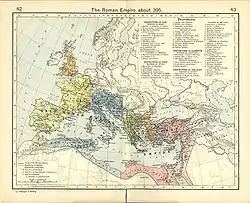Stridon
Stridon (Latin: Strido Dalmatiae) was a town in the Roman province of Dalmatia, of unknown location, best known as the birthplace of Saint Jerome. In 379, the town was destroyed by the Goths. Jerome wrote about it in his work De viris illustribus:[1] "Jerome was born to his father Eusebius, [in the] town of Strido, which the Goths overthrew, and was once at the border between Dalmatia and Pannonia." ("Hieronymus patre Eusebio natus, oppido Stridonis, quod a Gothis eversum, Dalmatiae quondam Pannoniaeque confinium fuit...").

.jpg.webp)
Location
The exact location of Stridon is unknown. It is possible Stridon was located either in modern Croatia or Slovenia. Possible locations are the vicinity of Ljubljana,[2] Starod (Slovenia), Sdrin, Štrigova, Zrenj, Zrin (Croatia) and many others in both countries.[3][4][5] However, according to other sources, such as Frane Bulić in his work Stridon (Grahovopolje u Bosni) rodno mjesto Svetoga Jeronima: rasprava povjesno-geografska (1920) and the geographical map of the Roman Empire in 395 AD from Historical Atlas (1911) by William R. Shepherd, Stridon, which was the seat of a bishopric, is placed at 44.2N, 17.7E, in today's Bosnia and Herzegovina, in Grahovsko polje, near the town of Grahovo.[6][7]
Notable people
Other than Saint Jerome, the priest Lupicinus of Stridon came from Stridon, and Domnus of Pannonia, a bishop who took part in the First Council of Nicaea, is often said to have come from or been bishop of Stridon or, more likely, the bishop of Sirmium.
References
- Jerome, De viris illustribus, ch. 135.
- "Decorative Arts: Renaissance - Saint Jerome and the Lion". Louvre.fr. 2010. Archived from the original on 15 June 2011. Retrieved 1 February 2010.
- "Neizčrpen vir" [An inexhaustible resource]. www.druzina.si.
- Josip Florschütz (October 1902). "Stridon i Zrin" [Stridon and Zrin] (PDF). Vjesnik Arheološkog muzeja u Zagrebu (in Croatian). 6 (1): 87–98. ISSN 0350-7165. Retrieved 30 September 2011.
- Antun Mayer (January 1942). "Stridon" [Stridon] (PDF). Vjesnik Arheološkog muzeja u Zagrebu (in Croatian). 22–23 (1): 175–185. ISSN 0350-7165. Retrieved 30 September 2011.
- Bulić, Frane (1920). "Stridon (Grahovopolje u Bosni) rodno mjesto Svetoga Jeronima: rasprava povjesno-geografska" [Stridon (Grahovopolje in Bosnia) the birthplace of St. Jerome: a historical-geographical discussion]. Journal of Dalmatian Archeology and History, v. 43 (in Bosnian and Croatian). Zemaljska štamparija - Sarajevo. Retrieved 30 October 2013.
- Shepherd, William R. (1911). "The Roman Empire about 395". Historical Atlas. New York: Henry Holt and Company. pp. 42–43. Retrieved 4 March 2019.